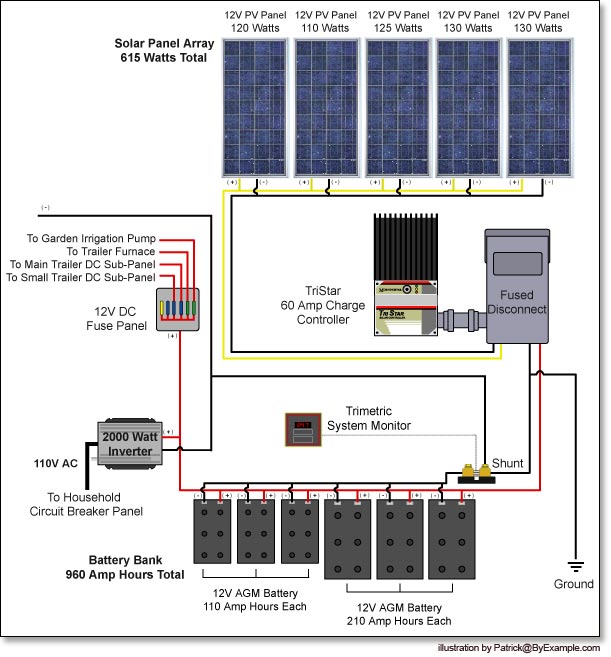Our Current Power System
Over the course of the past few months we've upgraded our 12 volt solar power system to accommodate an increase in power usage. While this is not our final system many of the parts that we purchased for this version will be reused in a larger 24 volt system which we will use to power our future home.
We've been living off the grid now for almost three years and we've never run out of power. Yes, we are conservative with power when the need arises, but our solar power system has never crashed, not even once. While our new 615 watt system is modest in comparison to many of our neighbor's solar power systems, we have plenty of power to do the things that we need to do. The new solar power system supports our expanded office which includes a satellite Internet system, as well as four laptops and a printer. We've also recently reengineered our water system, doubling our pumping power by ganging two 12 volt pressure pumps together. The new water system consumes twice as much power, though it is easily supported by our 615 watt solar power system. We've also been running fans, using power driven kitchen appliances and charging batteries for our power tools.

System Monitor
The greatest advantage of our new system is the Trimetric system monitor, which allows us to monitor our power usage throughout the day and night. The Trimetric also tracks the amount of power that we have stored in our batteries for night time use. Without this monitor we would not be able to accurately gauge the amount of power that is available for use.
The shunt is part of the monitoring system. It is located near the batteries in order to take the most accurate system reading possible. The Trimetric display is located inside which allows us to easily check our system status.
Charge Controller
The charge controller is the "brains" of the solar power system. It monitors the batteries and the incoming power from the solar panels and intelligently directs and controls the flow of electricity into the batteries. As batteries come closer to being full, they must be charged more slowly or they will overheat and/or boil over (which damages your batteries). This system has a TriStar 60 amp charge controller.
We selected this charge controller because it is versatile. We can expand our 12 volt system to include six panels and still use this same charge controller. If we desire a larger 12 volt system we can pair two TriStar controllers to double our charging capacity. More likely, we will advance to a 24 volt system in the next year and we will still be able to use the TriStar controller.
Batteries
Batteries store power for use when the sun isn't out. This system includes three 110 Amp Hour AGM batteries which we purchased slightly used, in addition to our three original 210 Amp Hour AGM batteries. Our total battery storage is now 960 Amp Hours.
With most deep cycle batteries it's a good practice to only drain your batteries to "half" the power level. That's just under 500 Amp Hours of available power. At our current level of power usage that should last us 3 to 5 days should there be no incoming power from the panels. The batteries are connected to one another and the charge controller via 2 gauge wire.
Solar Panels
We've also increased the number of solar panels in our system to five, which gives us a total of 615 watts of power during full sunlight. Though we have several different models and sizes they all work together in our 12 volt system to harvest electricity from the sun. In our 24 volt system we will lose a small amount of efficiency due to the varied sizes, but unless you are able to purchase all of your panels at one time it is hard to achieve uniformity. If you are planning to move to a 24 volt system and will be piecing it together it would be best to purchase solar panels in identical pairs.
In this system the five solar panels are wired in parallel so that the voltage remains 12 volts and their power output is combined to a total of 615 watts. This array of panels is then connected via two 20 foot lengths of 10 gauge, sun resistant romex to the charge controller. There's a fused disconnect between the Panels and the Charge Controller (positive lead only) so that the panels can be switched off in the case that the Charge Controller needs maintenance or repair.
AC Inverter and Fuse Panel
The inverter is tied directly to the batteries at the end of the 2 gauge battery wire. The inverter converts the 12 volt DC electricity into 110 volt AC (standard household voltage) so that we can run basic home appliances. At present we are using a 2000 watt modified sine wave inverter -- that's about a max of 18 amps of 110 volt AC electricity.
All DC Loads are tied into the DC fuse panel. Our pressure pumps, furnace fan, lights, electronic controls on the propane refrigerator all run off of 12 volt DC electricity. The fuse panel sub-divides and individually fuses the various circuits much like the circuit breaker box in the average home. Our DC fuse panel uses the same type of fuses commonly found in automobiles today.
Going Solar?
To read more about our perspective on off-grid living and the need for sustainability, click here.
To see the diagram of our previous solar power systems, click here.